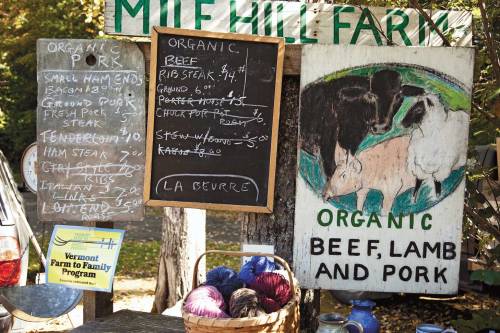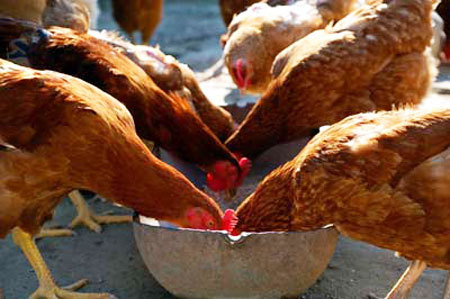#sustainable food
Canning Fire Roasted Tomato Salsa Recipe
Tomato season is finally upon us. You have no idea how giddy this makes me. Yesterday I pulled off two Sungold cherries, two Jaune Flamme saladettes and who knows what the other red variety was. I’ve lost track. And my peppers are not far behind. It’s time to start thinking about salsa!
Post link
Tomato season is finally upon us. You have no idea how giddy this makes me. Yesterday I pulled off two Sungold cherries, two Jaune Flamme saladettes and who knows what the other red variety was. I’ve lost track. And my peppers are not far behind. It’s time to start thinking about salsa!
Post link
All About Eggs: Stir-Fried Sprouts, Spinach and Mushroom Omelette
It’s an old favorite, spinach and mushroom omelettes, and rightfully so. Those two ingredients just go well together. Now stir-fry them with bean sprouts and you’ll really have something special!
By Diane M. Lindamood
Photo by the American Egg Board
Post link
Ginger Broccoli Stir-Fry Recipe
This ginger broccoli stir-fry recipe is the perfect way to incorporate fresh vegetables and herbs from your garden into a healthy, satisfying meal.
By the MOTHER EARTH NEWS Editors
PHOTO: FOTOLIA/ILDI
Post link
Nominations Sought for 2015 Moses Organic Farmer of the Year Award
The Midwest Organic and Sustainable Education Service (MOSES) is seeking nominations for the “2015 MOSES Organic Farmer of the Year” award, which will be presented at the 26th annual MOSES Organic Farming Conference in La Crosse, Wis., Feb. 26 to 28, 2015.
The award recognizes an organic farmer or farm family with a history of outstanding land management, resource conservation, and farming innovation. These exemplary farmers also are committed to spreading the organic message in their communities. This is the 13th year for the award program, which comes with a prize package that includes full admission to the 2015 MOSES Conference.
North Dakota seed and grain farmers, David, Ginger, Dan and Theresa Podoll of Prairie Road Organic Farm and Seed in Fullerton, ND, received the 2014 MOSES Organic Farmers of the Year award. Their farm story and other recipients’ stories are online at the MOSES website under the “Projects” tab.
Anyone can nominate a farmer for this award. Nomination forms are available on the MOSES website, or by calling the MOSES office at 715-778-5775. Nominations are due by Sept. 15, 2014.
This prestigious award comes with a number of prizes including a cash award, lodging, a bookstore gift certificate and full admission to the Organic Farming Conference, the nation’s largest gathering of organic farmers.
Post link
The recipe is modified from Ball Complete Book of Home Preserving by Kingry and Devine.
We love pickles and that does not just mean cucumbers. Pickled okra, green beans, baby onions, beets- and our new true love; pickled asparagus. We pick the asparagus every day and keep it in 2’“ water until we have a few quarts. Longer spears can be snapped in half and with ends placed in water and stored in the refrigerator. [Get the recipe!]
Post link
Homemade Onion Powder
Make your homegrown onions last even longer and avoid processed, store-bought alternatives by following this homemade onion powder recipe.
By Linda Deming
Photo by Fotolia/Deyan Georgiev
Post link
Landscaping With Logs for a Whimsical Garden Design
Incorporate log rounds into your garden design for an earth-inspired touch. Landscaping with logs is easy, not to mention free!
By Craig Braunschweig
Post link
All You Need to Know to Eat Good, Grass-Fed Meat
Learn how to choose and use inexpensive cuts of grass-fed beef, free-range chicken and pastured pork for better nutrition and out-of-this-world flavor.
By Deborah Krasner
Photo by MARCUS NILSSON
Post link
Growing Grains
Growing, harvesting, milling and using amaranth, corn, wheat, oats, rye and triticale.
By John Vivian
Post link
It’s the time of year when we get focused in on tomatoes. Drying, boiling, freezing, slicing, and seed saving.
We finally got a chance to taste test the new potato onions in a delicious stir fry.
I learned recently that late spring is the best time to eradicate ragweed instead of mid summer.
Wineberries are extremely yummy but they produce so little fruit we decided to delete our patch.
Post link
All You Need to Know to Eat Good, Grass-Fed Meat
Learn how to choose and use inexpensive cuts of grass-fed beef, free-range chicken and pastured pork for better nutrition and out-of-this-world flavor.
By Deborah Krasner
Photo by MARCUS NILSSON
Post link
Spice Up Your Stir-Fry With Homemade Soy Sauce
Homemade soy sauce is easy to make and you can reap other edible delicacies, such as tofu or sprouts, during the process.
By R. Lewis Canupp-Penrod
Post link
What To Feed Chickens: Formulating Your Own Chicken Feed
Joan Salmonowicz tells readers what to feed chickens, how to mix your own chicken feed, including buying mixed ration feed in bulk, feed ratios, and common supplements.
By Joan Salmonowicz
PHOTO: FOTOLIA/KNEIANE
Post link
Make Your own Fermented Dairy Products
Tap the benefits of delicious fermented dairy products.
By Lynn Keiley
Photo courtesy Scott Hollis
Post link
Best Chicken Breeds for Backyard Flocks
Use our survey results to help you choose the best chicken breeds for egg or meat production, temperament, and more.
By Troy Griepentrog
PHOTO: ISTOCKPHOTO/KEVIN EAVES
Post link
Long Noodles Recipe With Salted Black Beans and Bok Choy
This mouthwatering Long Noodles Recipe with Salted Black Beans and Bok Choy Recipe will surely change the minds of vegan-food skeptics everywhere.
By Kim O’Donnel
Photo Courtesy Da Capo Press
Post link
As the oils produced from the microalgae are edible and have superior properties to those found in palm oil, the newly discovered method would serve as a healthier and greener alternative to palm oil, according to the research study published in Journal of Applied Phycology.
Compared to palm oil, the oil derived from the microalgae contains more polyunsaturated fatty acids, which can help reduce ‘bad’ cholesterol levels in blood and lower a person’s risk of heart disease and stroke, the study states.
Palm oil is the most widely consumed vegetable oil on the planet, found in many packaged products sold in the supermarket. While palm oil is the most efficient source of vegetable oil, its rapid expansion threatens some of the planet’s most important and sensitive habitats. The algae oil innovation could present a possible alternative that can stop the damage.
Besides serving as a greener alternative to cultivating palm trees for plant-based oils or fat, the NTU-developed technique also has the potential to help cut down on greenhouse gas emissions as well as food waste.
Source: Phys.org (link in bio)
#sustainability #algae #science #futurefood
https://www.instagram.com/p/CcNlFTxrt3G/?igshid=NGJjMDIxMWI=
Post link
Solarpunk Food
Let’s do a little thought exercise about food. Diet culture makes us isolated while the commodification of food pushes global food trends instead of regional variation. But we’re solarpunks, right? So we’re all about imagining a better future. Let’s imagine a world where we’ve healed our cultural relationship with food and are sourcing things more locally.
Think about where you live right now. Think about the kinds of things that can be raised or grown in your area. Then start to think about what recipes could be made for the following social events. We’re going to start small to make this more manageable, ok? Do as many or as few of these as you feel up to doing.
In this bright sustainable future full of local ingredients:
- What snack are you bringing to game/movie night?
- What soup do you make for a sick loved one?
- What’s your go-to potluck recipe?
- What treat do you welcome a new neighbor with?
- What hot beverage do you share in fall/winter?
- What cold beverage do you share in spring/summer?
How did that feel? What did you come up with?
Maybe these recipes can be worked into solarpunk stories. Maybe they can be made into a little cookbook. Maybe locally sourced ingredients are inaccessible to you right now, but are there any recipes you could start practicing anyway?
I love this idea! I’ve definitely been getting more experimental with food and drink over the pandemic. For example…

WITH LILACS!! (Very proud of my recent huge batch of simple syrup!) If you just want the recipe for lilac syrup, scroll straight to the bottom.
However I’m also going answer all the questions, since I have been planning to play around more with underused local ingredients. So in this ideal world…
1. Fresh/dried pawpaw! I recently learned these fruit trees are native to my area, though wild ones are now rare. That was a huge surprise because I’m Canadian and I thought they were more subtropical, but I’m juuuust within the northern tip of it’s range. I’ve yet to try it, but I’ve heard it compared to mango, which I love.
2. Creamy duck and mushroom soup. I already make this one, though I often have to settle for creminis, and would prefer a variety of local wild mushrooms. The couple times I’ve been able to get my hands on some it really brought it to the next level!
3. Chili with wild rice and/or corn chips. I currently use standard grocery store ingredients, but pretty much all of them can be grown locally in the summer and canned/stored dry for use in the cold seasons. I’ve never tried the rice that’s native to where I live, but it’s long been a staple of indigenous cuisine and it’s on my list of things to check out.
4. Fresh baked bread ☺️ With butter and homemade raspberry jam. Or maybe blueberry. There’s plenty of berries to choose from here!
5. I love making mulled wine and cider for my friends, and while grapes and apples grow here, it does require a bunch of imported spices. If I had to choose something without, maybe cedar tea with honey? While I haven’t tried it myself yet, I’m a big fan of evergreeny flavours, so I suspect it would be right up my alley.
6. LILAC LEMONADE. This is already my signature drink for spring/summer parties, and it’s quite easy to make. Yes I knoooow, lemons aren’t native, but you can grow them in greenhouses and in pots. My mom actually has a potted one that fruits every year! I can’t really say the same for the sugar, but hey, we said this was an ideal world, so let’s assume it’s produced ethically and sustainabily in this scenario.
But. Back to the LILACS. They’re one of my favourite flowers, the smell is heavenly, but they’re a short-lived seasonal experience. Enter simple syrup! Because it turns out, like many flowering trees, lilacs are edible! You need to be sure they haven’t been exposed to harmful pesticides, but other than that you’re good to go. Once you have the syrup, it can be safely stored in the fridge for at least a few weeks, or frozen almost indefinitely and brought out to mix with drinks whenever you like. It’s quite nice in a gin and tonic, but my go-to crowd pleaser is the lemonade.
So here’s my recipe:
1 Cup white sugar
1 Cup water
2 Cups lilac blossoms (Less precise than the other measurements. I use very generous cups)
Optional: 3-4 berries or other colourant. Left alone, the syrup is usually a light brown, with a muted tint that reflects the colour of your lilacs. I’ve successfully used blackberries, blueberries, and plum skins in small amounts to add a rich purpley-red colour without changing taste, which then dilutes to bright pink in my lemonade.
- Snip off several bunches of lilacs, then rinse thoroughly to remove bugs and dirt. Gently shake the water off and lay them on a towel to dry while you prep. (It may be hard to judge how much this will yield until you’ve done it a few times, but I pile mine into an 11" mixing bowl and find this works out to roughly 8 cups of individual blossoms.)
- Remove the blossoms by hand or with a small pair of scissors, leaving as little stem as you can. It’s tedious, but worth the effort to keep the bitter green bits out of the mix.
- Add the water to a pot on high heat and bring to a strong simmer. You can go full boil just keep in mind it shouldn’t stay there for the next steps.
- Add the sugar and lower heat to medium. Stir continuously to avoid burning any sugar at the bottom.
- Once the sugar is fully dissolved, stir in the lilac florets plus whatever you add for colour, and bring heat down to low. Cover and let simmer for 10 minutes.
- Remove from heat and allow to steep (like tea) for up to 8 hours, remaining covered. This is flexible, but I suggest at the very least to let it steep until it reaches room remperature, and not to go over a full day, as it can increase bitterness beyond a certain point. I like to make mine first thing in the morning and come back to it around dinner.
- Pour the syrup through a fine mesh strainer and into a clean vessel. Use a spoon to aggressively squeeze out every last drop of flavour from the remaining mush.
- To store, I recommend corked/capped bottles for the fridge, and sealable plastic containers for the freezer. I find old yogurt tubs perfect for this. Remember to leave room for expansion! Filling only ¾ of the way is generally enough.
And this is the rough ratio I use for the lemonade:
750 ml Lemon juice (equivalent to about 15 lemons)
1 L Lilac syrup
2 L Water
I tend to wing it on this part and adjust to taste, so you may want to play around a bit to find the balance you like.
And playing around is half the fun! This method can also be applied to pretty much any foraged edible flower, such as cherry blossoms, magnolias, violets, etc. Just make sure to do your research if you try a new plant so you know it’s safe.

The oyster has been the ultimate symbol for edible aphrodisiacs. It is the universal emblem for sex and fertility. As Spring is the time to plant seeds and the Oyster has the magical ability to make pearls, in Connecticut we are lucky enough to have some wonderful Atlantic bivalve mollusks that are plump and appealing in salinity. Oysters thrive in Connecticut’s tidal waves and brackish coasts. Consumed by Connecticut’s Native Americas in great numbers, the early Europeans saw oysters as a viable staple in their colonial diets. There are many shellfish species associated with the Connecticut shoreline; however the oyster is king and respected for its flamboyant history, economic foundation, and revered reputation for excellence. I love serving them because they are sexy and an easy amuse bouche or starter for your honored guests. Once you get the hang of opening them which is easy when you have the right tools, all you have do is make a simple dressing or just have some interesting hot sauces and a little horseradish if you like and you have a superb start to a great evening.The mignonette below is super fast and compliments the brininess of the oysters with the sweetness of mango. Since it is spring and we all need a break, this recipe makes a tropical bite size treat.
½ cup mango juice
¼ cup minced chives
1 ½ teaspoons freshly ground white pepper
Combine all of the ingredients in a medium bowl and serve over freshly shucked oysters and clams.




















